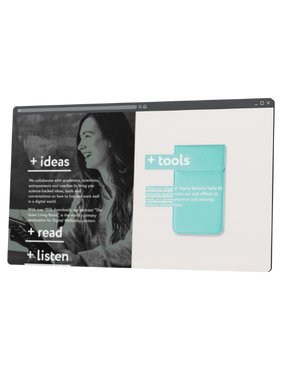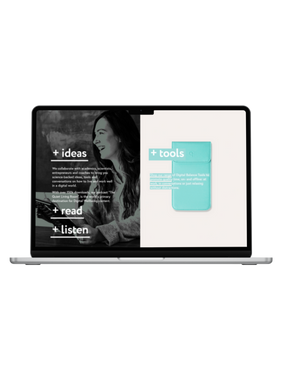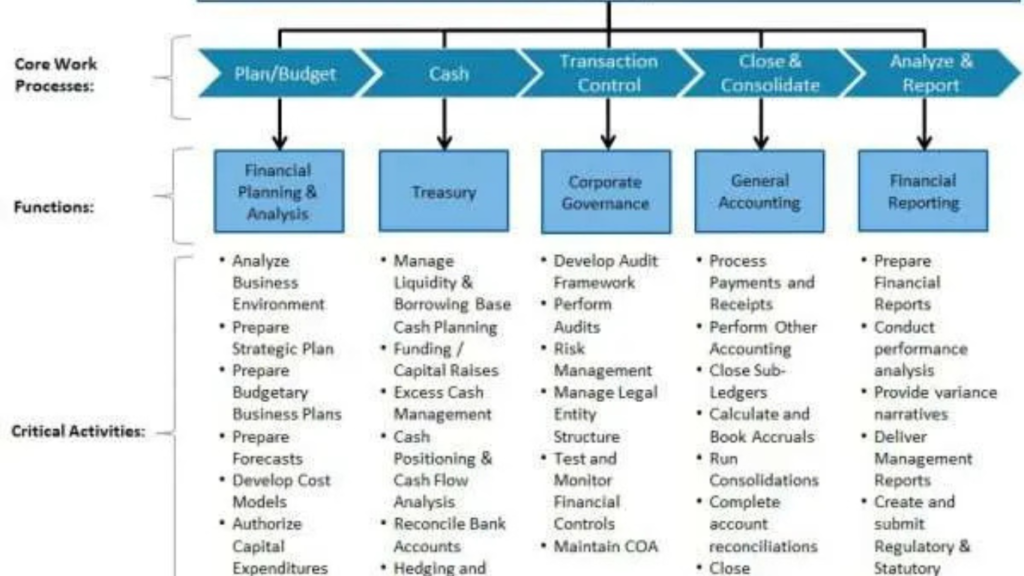
Quiet Social Club
The club offers a variety of resources, including device-free experiences, self-care practices, workshops, talks, and digital balance tools.
Audience: In the process of designing the eLearning platform for Quiet Social Club, we targeted individuals who were keen on improving their digital well-being and creating a balanced relationship with technology. The platform catered to both beginners with little understanding of mindful technology use and those seasoned individuals looking to refine and enhance their digital habits. It was developed to serve those seeking a holistic and scientifically backed approach to digital well-being, leveraging strategies such as mindful usage, self-care practices, and compassionate communication. We aimed to empower individuals to live more balanced, purposeful lives by transforming their relationship with technology.
Responsibilities: instructional design (action mapping, storyboarding, mockups, prototype, full build), visual design (website design, landing page design), customer journey mapping, sales funnel automation
Tools Used: Kajabi, WordPress, PowerPoint, Google Docs, Canva, Zoom, Google Drive, Mailchimp, Slack.

The Problem and Solution
Analyzing a start-up like Quiet Social Club as an instructional designer, the primary challenge involved effectively educating and empowering individuals to adopt healthier digital habits, given their varying levels of digital literacy and dependence on technology. Delivering a comprehensive curriculum that catered to both beginners and experienced users, ensuring content is relevant, accessible, and engaging, was essential. Additionally, maintaining high user engagement and facilitating the practical application of theoretical knowledge were crucial. Building a supportive community for continuous guidance and feedback, scaling the platform to accommodate growth, and seamlessly integrating various tools for a cohesive learning experience presented significant challenges. Addressing these challenges required a strategic, adaptive approach to create an effective and empowering learning experience for the target audience.
To address the diverse learning needs and goals of Quiet Social Club’s audience, we used Kajabi, WordPress, PowerPoint, Google Docs, Canva, Zoom, Google Drive, Mailchimp, and Slack cohesively. We started by identifying audience segments and their specific learning objectives using a flow chart. We then developed engaging content tailored for each segment, utilizing Kajabi for interactive courses and community forums, while PowerPoint was used to create visually appealing presentations with interactive elements. Google Docs supported the creation of detailed guides, e-books, and feedback forms to gather insights and maintain process documentation. Canva was employed to ensure consistent branding with engaging visuals, banners, and social media posts. Zoom facilitated webinars and live sessions, enhancing real-time interaction and learning. Google Drive was used for collaborative content development and storage.
Mailchimp handled automated email campaigns to nurture leads and maintain engagement, and Slack provided a platform for ongoing communication and support among the team. This integrated approach ensured comprehensive content delivery, continuous engagement, and regular updates based on feedback, ultimately enhancing the educational experience for all audience segments.
My Process
To bring the Quiet Social Club project to life, I leaned on a variety of tools and platforms. The outcome was a robust community membership program where members participated in live sessions once a month, fostering a sense of community and continuous learning. The automated processes ensured that members received regular updates, valuable content, and ongoing support, creating a dynamic and empowering learning environment. This strategic, adaptive approach not only met the diverse needs of the audience but also created a sustainable and engaging educational experience.
Our mission was to help individuals, organizations, and communities transform their relationship with technology to live to their full potential. By offering a variety of resources, such as device-free experiences, self-care practices, workshops, talks, and digital balance tools, we emphasized mindful digital habits, compassionate communication, and meaningful connections both online and offline. This balanced approach was instrumental in living fully and with a greater purpose.
We collaborated with experts from various fields to offer science-backed tools and ideas. One of the standout features of the project was the popular podcast, “The Quiet Living Room,” which focuses on digital well-being and has attracted a significant following. This community is built around the philosophy of fostering a balanced and fulfilling lifestyle.
By strategically leveraging platforms like Kajabi for hosting interactive courses and community forums, WordPress for creating an engaging website, and Canva for designing visually appealing materials, we ensured consistent branding and a cohesive user experience. We used Zoom for live sessions and webinars, Google Docs for comprehensive guides and documentation, and Mailchimp for automated email campaigns to keep members informed and engaged. Slack facilitated ongoing communication among team members, ensuring that we stayed connected and aligned throughout the project.
Overall, this project created a supportive and empowering environment where members could thrive and transform their digital habits, leading to a more balanced and fulfilling lifestyle.
Action Map
I consulted with an experienced digital well-being advisor as my SME. Together, we created an action map that outlined common challenges faced by individuals looking to improve their digital habits and balance their relationship with technology. Through this process, we noticed a common theme: the need for clear, accessible education on mindful technology use and digital well-being. This insight allowed us to create the learning goal we wanted to achieve with our educational materials: individuals will understand and implement best practices for digital well-being to enhance their overall quality of life.
From there, the SME narrowed down the top three high-priority actions that would serve as the foundation for our educational content: understanding the impact of digital habits on mental health, developing effective self-care and mindfulness practices, and fostering meaningful connections both online and offline.
These actions were designed to be incorporated into a comprehensive learning platform using Kajabi, supplemented by visually engaging presentations and infographics in PowerPoint, detailed guides and feedback mechanisms in Google Docs, and interactive features facilitated by Zoom and Slack.
This strategic approach aimed to empower individuals by providing them with the necessary knowledge and tools to succeed in achieving digital balance and well-being.

Full Development
After collecting feedback and applying several iterations to refine the approach, the project for “Quiet Social Club” resulted in a comprehensive program designed to educate and empower individuals to improve their digital well-being.
In-depth Process:
~Audience Segmentation and Content Mapping: We began by using flow charts to create an action map, segmenting the audience into beginners, experienced users, and those seeking advanced digital well-being techniques. This helped us tailor content specifically to each group’s needs and learning objectives.
~Content Creation: Utilizing Kajabi, we developed over 120 modules that included videos, quizzes, downloadable resources, and interactive elements. This platform allowed us to deliver engaging and structured educational content effectively.
~Visual Design and Presentations: Canva and Adobe Photoshop were crucial for designing visually appealing materials such as banners, social media posts, course thumbnails, and infographics. PowerPoint was used to create detailed presentations for webinars and workshops, simplifying complex concepts with interactive elements.
~Guides and Documentation: Google Docs was employed to write comprehensive guides and e-books, maintain detailed documentation of the instructional design process, and create feedback forms to gather insights and continuously improve the content.
~Community Engagement and Feedback: Kajabi’s community forum feature enabled interaction and support among users. We also implemented feedback mechanisms to gather user input and make iterative improvements.
~Email Campaigns: A key aspect of the project was developing scripted email campaigns using Mailchimp to nurture leads and maintain engagement. We crafted personalized email sequences for each audience segment, providing regular updates, valuable content, and calls to action. These campaigns were designed to guide users through their learning journey, from initial interest to active participation and digital well-being transformation.
This comprehensive approach ensured that “Quiet Social Club” was not only informative and engaging but also responsive to the needs of its diverse audience. It ultimately fostered a supportive and empowered community, promoting a balanced and fulfilling digital lifestyle.
Reflection & Takeaways
Feedback Process:
Throughout the Quiet Social Club project, the feedback process was an invaluable component that significantly influenced the outcome.
However, reflecting on the process, there are several key lessons learned and areas for improvement.
What Happened:
We implemented a robust system for collecting user feedback, utilizing tools like Google Docs for detailed feedback forms and Mailchimp for distributing surveys and feedback requests. This allowed us to gather both quantitative and qualitative data, providing insights into user experiences and preferences. Kajabi’s community forums and live sessions on Zoom also served as platforms for real-time feedback, enabling us to make immediate adjustments to the content and user experience.
Key Observations:
_In-depth User Insights: The feedback provided deep insights into the needs and challenges faced by our users, guiding us in refining the content and features.
_Engagement: High levels of user engagement in the feedback process indicated a strong sense of community and investment in the platform’s success.
_Immediate Adjustments: Real-time feedback during live sessions allowed for swift adjustments, ensuring the content remained relevant and effective.
Lessons Learned:
_Timely Feedback Implementation: While we effectively collected feedback, there were instances where the implementation of changes based on feedback was delayed. Ensuring a quicker turnaround time for incorporating user suggestions would enhance the overall experience.
_Comprehensive Feedback Mechanisms: Although we utilized multiple tools for feedback, there was room to streamline the process. Integrating a more comprehensive and user-friendly feedback mechanism within the platform could simplify the process for users and provide a centralized repository for all feedback.
_User-Centric Iteration: The iterative process of collecting and acting on feedback was successful, but future projects could benefit from more frequent and structured feedback cycles. This would ensure continuous improvement and keep the content aligned with evolving user needs.
What I Would Do Better:
_Faster Integration of Feedback: Implementing a more efficient system for analyzing and integrating feedback promptly would ensure that user suggestions are reflected in the platform more quickly.
_Enhanced Feedback Tools: Developing or integrating tools that allow for more seamless and intuitive feedback collection would improve user participation and the quality of the feedback received.
_Regular Updates and Communication: Keeping users informed about how their feedback is being used and the changes being made can foster a stronger sense of community and trust. Regular updates and transparent communication about the feedback process would enhance user engagement and satisfaction.
Overall, the feedback process was a crucial element of the Quiet Social Club project. By learning from our experiences and continuously improving our approach, we can create even more effective and responsive educational platforms in the future.
